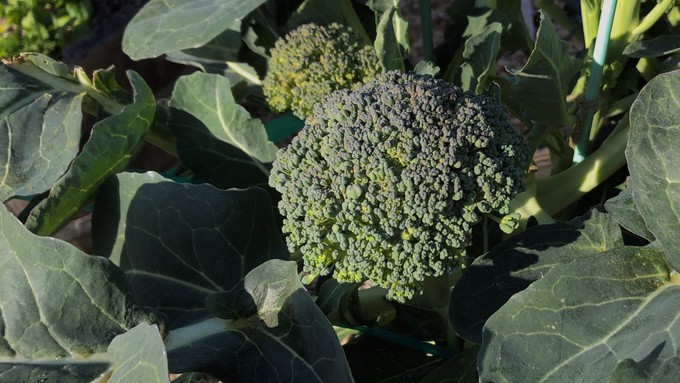
Broccoli is top pick, according to internet searches

In the past five years, California gardeners searched “how to grow broccoli" more than any other cool-season crop. This broccoli grew at the Fair Oaks Horticulture Center, which will be open Saturday so gardeners can ask "how to grow" questions in person. Kathy Morrison
What’s the most popular winter vegetable to grow in California? If you judge by internet searches, it’s broccoli in a green wave.
That’s the conclusion of researchers at AllAboutGardening.com, who scoured five years of Google Trends data to come up with a list of state-by-state winter favorites. (Their key phrase: “How to grow.”)
California gardeners searched “how to grow” broccoli more than any other cool-season crop. That was also the top search for seven other states including Michigan, Georgia and West Virginia.
No. 1 overall was garlic, say the researchers. That crop was the top search in 12 states from Hawaii to New York. (Considering garlic needs some chill to set solid heads, Hawaiian gardeners may have searched, “Can I grow garlic?” not just “how.”)
In third place were onions, the favorite search of seven states led by Texas and Oklahoma. With six states ranging from Florida to Colorado, lettuce edged out carrots, which was the top search in five states (including Nevada).
Four vegetables – radishes, cauliflower, Brussels sprouts and collard greens – were picked by two states apiece. Interestingly, the states doing the searching may be because those winter crops were more challenging for those gardeners. Radishes, for example, were the top search in Idaho and Kansas, two states that tend to get too cold for frost-tender radishes to thrive. Collard greens were tops in Minnesota and Massachusetts, two states not necessarily linked to this staple of Southern cooking.
Four vegetables were tops in just one state: Spinach (Wisconsin), beets (Utah), peas (Arkansas) and cabbage (South Carolina).
As for would-be broccoli growers in California, AllAboutGardening.com had this advice: Start indoors and transplant as summer’s heat starts to fade (we hope soon). From seed, broccoli needs 85 to 100 days to mature to a full-size head. Prolong broccoli season by cutting off the main head when ready, then harvest side shoots as they mature.
According to UC master gardeners, the best broccoli varieties to grow depends on what you want.
“Opt for varieties such as 'Calabrese', 'Green Comet' and 'De Cicco' for up to three months of extended harvest of side shoots; or choose 'Green Comet' and 'Green Magic' for large heads,” say the master gardeners. “Plant 'Cruiser' and 'Packman' for fast growth to maturity.”
California farmers produce a lot of broccoli each winter with about 40% of the crop grown in Monterey County, where they enjoy the most days of perfect broccoli weather – 60 to 65 degrees.
Central Valley farmers grow varieties that are more heat and cold hardy. In the San Joaquin Valley (another major broccoli-growing area), top cultivars include Avenger, Expo, Green Magic, Legacy, Marathon, Monte Carlo and Tradition.
For more tips on growing broccoli: http://ipm.ucanr.edu/PMG/GARDEN/VEGES/CULTURAL/broccoliplant.html
Comments
0 comments have been posted.Sacramento Digs Gardening to your inbox.
Food in My Back Yard Series
May 6: Maintain soil moisture with mulch for garden success
April 29: What's (already) wrong with my tomato plants?
April 22: Should you stock up on fertilizer? (Yes!)
April 15: Grow culinary herbs in containers
April 8: When to plant summer vegetables
April 1: Don't be fooled by these garden myths
March 25: Fertilizer tips: How to 'feed' your vegetables for healthy growth
March 18: Time to give vegetable seedlings some more space
March 11: Ways to win the fight against weeds
March 4: Potatoes from the garden
Feb. 25: Plant a fruit tree now -- for later
Feb. 18: How to squeeze more food into less space
Feb. 11: When to plant? Consider staggering your transplants
Feb. 4: Starting in seed starting
Sites We Like
Garden Checklist for week of May 11
Make the most of the lower temperatures early in the week. We’ll be back in the 80s by Thursday.
* Plant, plant, plant! It’s prime planting season in the Sacramento area. Time to set out those tomato transplants along with peppers and eggplants. Pinch off any flowers on new transplants to make them concentrate on establishing roots instead of setting premature fruit.
* Direct-seed melons, cucumbers, summer squash, corn, radishes, pumpkins and annual herbs such as basil.
* Harvest cabbage, lettuce, peas and green onions.
* In the flower garden, direct-seed sunflowers, cosmos, salvia, zinnias, marigolds, celosia and asters. (You also can transplant seedlings for many of the same flowers.)
* Plant dahlia tubers.
* Transplant petunias, marigolds and perennial flowers such as astilbe, columbine, coneflowers, coreopsis, dahlias, rudbeckia and verbena.
* Keep an eye out for slugs, snails, earwigs and aphids that want to dine on tender new growth.
* Feed summer bloomers with a balanced fertilizer.
* For continued bloom, cut off spent flowers on roses as well as other flowering plants.
* Add mulch to the garden to maintain moisture. Mulch also cuts down on weeds. But don’t let it mound around the stems or trunks of trees or shrubs. Leave about a 6-inch-to-1-foot circle to avoid crown rot or other problems.
* Remember to weed! Pull those nasties before they set seed.
* Water early in the day and keep seedlings evenly moist.